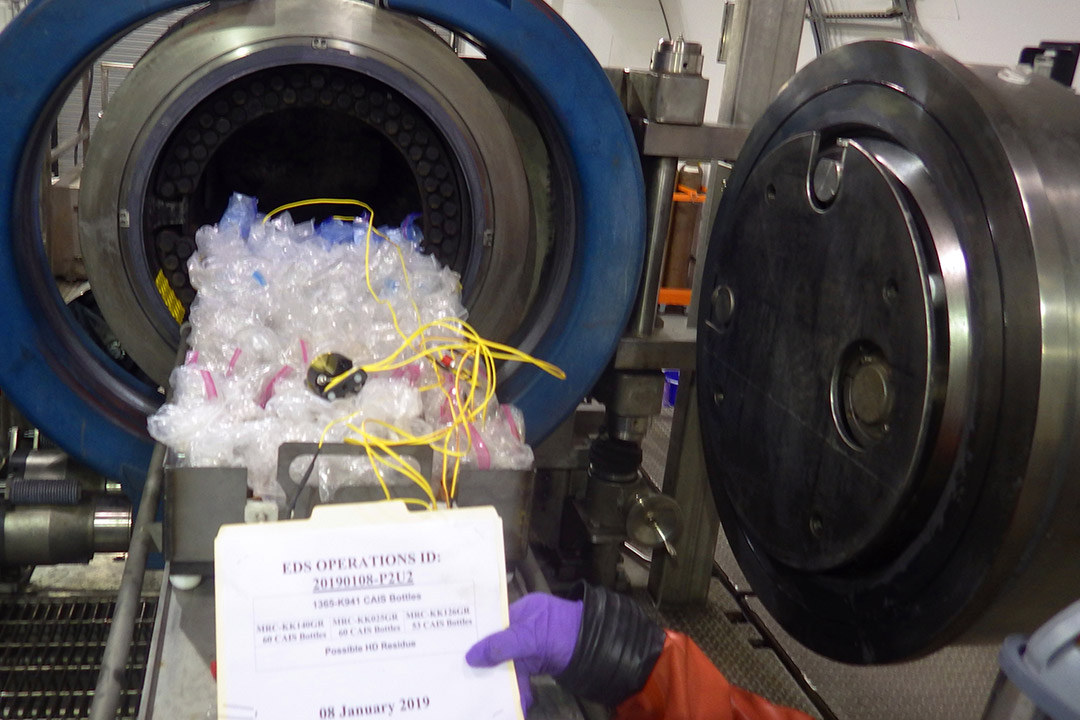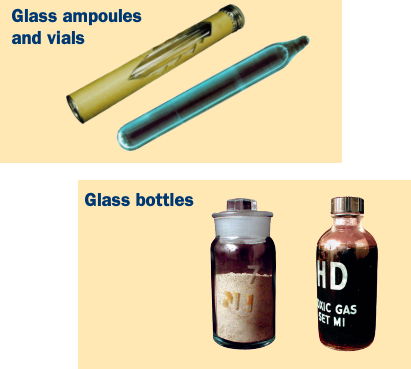// NEWS RELEASE
Team Puts Existing Chemical Destruction Technology to New Use at Pine Bluff Arsenal
CCDC Chemical Biological Center Public Affairs | April 11th, 2019
Team Puts Existing Chemical Destruction Technology to New Use at Pine Bluff Arsenal
DEVCOM CBC Public AffairsApril 11th, 2019

A tray of chemical agent identification sets is prepared for destruction using the Explosive Destruction System at Pine Bluff Arsenal (Photo credit: CCDC Chemical Biological Center)
Chemical weapons destruction experts from the U.S. Army Combat Capabilities Development Command Chemical Biological Center, in partnership with the U.S. Army Chemical Materials Activity are working together to safely destroy items recovered at the arsenal by the U.S. Army Corps of Engineers including mustard-filled chemical agent identification sets (CAIS), five German Traktor rockets and one 4.2-inch mortar.
Pine Bluff Arsenal (PBA), located 35 miles south of Little Rock, Arkansas, has a history of chemical weapons production and storage dating back to 1941. The arsenal’s chemical weapons production mission ended in 1990, and over the years the Army has managed multiple campaigns to destroy the stockpiled and recovered chemical warfare material stored there.
Chemical weapons destruction experts from the U.S. Army Combat Capabilities Development Command (CCDC) Chemical Biological Center, in partnership with the U.S. Army Chemical Materials Activity (CMA), recently began an effort to safely destroy items recovered at the arsenal by the U.S. Army Corps of Engineers. The Corps of Engineers is overseeing a multi-year remediation effort to unearth items that were buried from past operations. Recovered items include suspected mustard-filled chemical agent identification sets (CAIS), five German Traktor rockets and one 4.2-inch mortar.
When the Corps of Engineers began recovering thousands of CAIS bottles, CMA recognized that the existing CAIS destruction system was inadequate. The effort required CMA’s equipment developer, Sandia National Laboratories, to explore using the Explosive Destruction System (EDS) to destroy larger numbers of the CAIS items at one time, which had never been done before.
The operators from the Center’s Chemical Biological Application and Risk Reduction (CBARR) Business Unit were a key part of that development effort. “In summer 2018, preliminary tests to determine the feasibility of the approach for leveraging an existing technology to destroy new items was performed in conjunction with CMA,” said Raymond DiBerardo, Pine Bluff EDS project manager for CBARR.
Pre-mission testing on various chemical demilitarization destruction technologies is a CBARR capability. The tests were conducted at the Edgewood area of Aberdeen Proving Ground.
“We normally destroy munitions in the EDS, but CAIS (glass bottles) are unique,” said DiBerardo. “We can destroy up to 178, 4-ounce bottles in one shot with the EDS.”

While they may be small, the CAIS did pose a few logistical challenges.
“Our team tested and adapted to the logistics of destroying a new item using the EDS,” DiBerardo explained. “We accounted for additional time requirements at the start of the operation to unpack and inspect the CAIS, changed the method of loading items into the EDS, and adjusted the clean-up procedures at the end of the operation to clear the vessel.”
The crew operating the EDS at PBA consists of 19 CBARR personnel. CBARR maintains a permanent presence at the arsenal, and the majority of the personnel working on the project are permanently assigned there.
“Leveraging local subject matter experts makes it easy to generate a team that is not only knowledgeable about EDS operations, but also the history and nuances of PBA,” DiBerardo said.
According to DiBerardo, once all the CAIS, rockets and mortar are destroyed in mid-May, the site will temporarily shut down until more items are recovered. At that time, the team will reassemble and restart operations.
As of March 20, 2019, 4,804 of 7,101 CAIS items had been successfully destroyed.
The U.S. Army Combat Capabilities Development Command (DEVCOM) leads in the discovery, development and delivery of technology-based capabilities to enable Soldiers to win our nation’s wars and come home safely. DEVCOM is a major subordinate command of the U.S. Army Futures Command. The DEVCOM Chemical Biological Center is the Army’s principal research and development center for chemical and biological defense technology, engineering and field operations. The DEVCOM Chemical Biological Center is headquartered at Aberdeen Proving Ground, Maryland.
